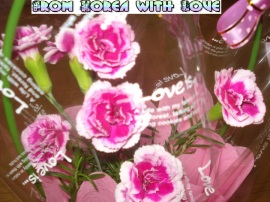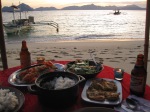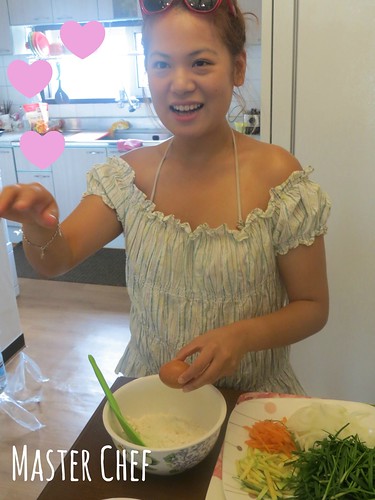![20130903-143724.jpg]()
My Faith and My Yoga Mat – A Prayerful Pose.
Rolling up my yoga mat and placing it back in the basket, my thoughts wander to about a year ago. So much time has passed since then, so many people have come and gone, so many things have changed, including me. Especially me.
I’m truly thankful for Kaizen, and the people I’ve met there, especially Simon and Mindy. They are two people with a driving passion for what they do. They are dedicated masters of their arts, and they inspire me daily to improve myself as they strive for constant improvement as well. I’m also thankful for the friends I have made because of the way we can encourage, motivate, challenge and comfort each other. Kaizen is like my home away from home. It’s a community of people where I feel safe and comfortable. I never imagined that I would be where I am now a year after, with a newfound avidity for exercise, as well as practicing yoga… Yoga? Yes, yoga.
A year ago, I would’ve told you that I firmly believed practicing yoga was wrong, due to its Eastern religious roots. Christianity and yoga is a very controversial topic among Christians, but I never joined the debate. I didn’t want to question it, and I felt like I should let sleeping dogs lie. It wasn’t until Simon suggested during one of my consultations that I should try yoga that I started wondering about it.
That was the start of a journey that not only brought me to the point where I am now, but also to knowing my Savior better.
To me, this was uncharted territory and I decided to explore it. For I believe that one has to be convinced of what one does, through the help of the Holy Spirit, by constantly asking and seeking His guidance. In doing so, these Godly convictions are accompanied by the peace of God that surpasses all understanding, and it becomes the fundamental foundation on which I make my decisions. (Phil 4:6-7) For all people view things differently; all people have different opinions. Yet the Word of the Lord is true and will stand forever, and His Spirit will lead me according to His statutes.
Like many other things in life, this journey started with questions that needed answering.
Yoga… what is yoga, and can Christians do it?
The term “yoga” means “yoke” or “to unite,” as in uniting the body, mind and spirit. Yoga, in its original form, is an ancient Eastern religious practice, related to Hinduism, and it still remains part of several Hindu practices today. However, things and times have changed and the yoga practiced nowadays only slightly resembles the original practice. There are thousands of different ‘styles’ of yoga, since everybody experiences yoga differently. We all have a different view on ‘what yoga is’ – our own definition of yoga.
It is undeniable that Hinduism involves yoga; however, all yoga is not Hinduism.
The way I’ve experienced it, is that yoga mostly focuses on the physical postures (asana) and the breathing exercises (pranayama). From what I’ve learned, yoga combines the breath and movement to develop and strengthen the body.
Other people might argue that yoga is pagan. Yet there are so many examples of pagan traditions that have been co-opted by Christians and used for worship, for example Christmas and Easter festivities. We, as Christians, all know that we celebrate the birth of our Lord and Savior, Jesus Christ, on Christmas and not Santa Claus, a tree or even the gifts. Just the same, Easter is a time when we focus on Jesus’ sacrifice for us on the Cross and on His resurrection, not on the Easter bunny and Easter eggs. Yet, we still enjoy the fun festivities and the ideas associated with the latter.
So in my opinion, to say that Christians cannot take a practice that was intended for something else and use it to worship God, is to ignore the transformational power of Christ. For Christ came to set us free. We are no longer slaves, living under the law; we are sons and daughters of God, with His Spirit living within us. We also know that Satan has no power over us, unless we give it to him. Christ freed us from bondage.
Yoga, Hinduism and Idol Worship
As a Christian, I know and believe that there is only One God: the Holy Trinity.
4 Therefore, as to the eating of food offered to idols, we know that “an idol has no real existence,” and that “there is no God but one.” 5 For although there may be so-called gods in heaven or on earth—as indeed there are many “gods” and many “lords”— 6 yet for us there is one God, the Father, from whom are all things and for whom we exist, and one Lord, Jesus Christ, through whom are all things and through whom we exist.”
1 Corinthians 8:4
31 So, whether you eat or drink, or whatever you do, do all to the glory of God.
1 Corinthians 10:31
Just as eating food cannot save me, in the same way, doing yoga does not determine my salvation; Jesus Christ does. He bought me at a very costly price – His own life. I do not worship idols through exercisng, for I know there is only one God, and He is the one who created me, who made my body and gave me the ability to exercise. Therefore, I will give thanks to God, and dedicate my yoga practice to Him daily.
If through practicing yoga, I cause a fellow Christian to stumble, it changes the situation, and I will stop practicing yoga for the sake of my fellow believer. But I have not yet encountered anyone who stumbled because of this reason. I experience my yoga practice as a time where I can meet God and connect with Him through, among others, meditating and praying while exercising. I believe it has become a part of my testimony.
Meditation and Looking Inward
Meditation is referenced throughout Scripture – Jesus did it, David did it and the Lord exhorted Joshua to do it.
8 This Book of the Law shall not depart from your mouth, but you shall meditate on it day and night, so that you may be careful to do according to all that is written in it. For then you will make your way prosperous, and then you will have good success.
Joshua 1:8-9
I see meditation as being mindful of something, thinking about it, paying attention to it. But not only that, I also see it as a time to listen. To me (and this might be different for all believers) prayer and meditation are closely knit together. Prayer is, to me, a conversation between God and me; meditation is the act of listening to God. It is through meditation, and constant prayer, that I came to receive my answer from God regarding my yoga practice. Jesus said that when we pray, it should be in solitude and with few words. (Matthew 6:5-8)
Through meditation, I also became aware of my thoughts, feelings, behavior, and physiological changes, and I’m able to submit all of it under God’s will. I allow Him to align it with His will for my life in order for me to serve Him, and the people around me, better. I also found that you can meditate on the Word (Scriptures), creation (the work of God’s Hands – Psalm 9) and gratitude – God is omnipresent, when we seek Him, we will find Him. (Jeremiah 29:13)
And what about looking inward, when Christians should be looking out towards Jesus? As Christians we agree that nobody can come to the Father but by Christ (John 14:6). Jesus gave us His Holy Spirit to dwell within us and to speak to us. I can look inward to receive new strength and faith from the Holy Spirit who dwells in me to do God’s will.
And my yoga practice? Did it change me, or my faith?
Before I started practicing yoga, I was very uncertain regarding the implications it would have on my life and my faith. I watched several YouTube videos, I read many articles and studied the Scriptures, and I talked to many people, including my pastors about this, I even discussed my concerns with Simon and Mindy. Through constant prayer and seeking God’s wisdom, I found peace and blessings in doing yoga. I can honor God through my practice, knowing that it’s for Him alone that I do it, for there is no other God.
So how did I change? In the beginning of this article, I said that I changed. Not only did my view on yoga as a Christian change, but my view about my body changed as well. Exercising and yoga definitely changed me a lot. Yes, I gained confidence, strength, and many other qualities, and I learned to overcome obstacles, to reach for my goals, and to believe in myself. But, the one thing that changed and had a huge impact on my relationship with God was my perspective on my own body and how I view myself.
When my eldest sister was pregnant with her son, she made a book, documenting the changes in her body every week of maternity as her little boy grew inside her. I remember talking with her about the wonder, no, the miracle of life. How fragile and precious it is. I have always viewed life as precious and as a miracle; just not my own. I have often seen my faults, the areas where I lack, all the parts that aren’t ‘perfect, beautiful, or good enough’, but I have never seen my own body as a miracle or as something precious. I remember the first time I was able to do a yoga pose and balance correctly. It opened up a new world. My body did something that it has never done before, something that I didn’t even know it could do. It clearly wasn’t out of my own power. No, it was through Christ, for He gives me the strength to do all things.
3 I can do all things through Christ who strengthens me.
Philippians 4:13
This has been my motto since I joined Kaizen. Nothing is impossible. Difficult doesn’t mean impossible. It simply means you have to work hard.
Nowadays, every time I manage to successfully do a new pose, I thank God for the way He made my body, and I stand in awe, knowing that He knows my body, my heart and my soul way better than I do myself. I truly am fearfully and wonderfully made, intricately woven together. (Psalm 139)
Yoga is just one part of my journey at Kaizen, but it’s a part that I truly enjoy and where I can grow.
Applying yoga in everyday life? Oh, yes!
I’ve learned a couple of things in my yoga classes that I’ve found to be just as applicable in everyday life.
1) Breathe in, breathe out– most of us are living a fast paced life where we struggle to find time for everything. We’re always in a rush, with something else waiting to be ticked off our never-ending ‘to-do’ lists. It’s stressful and it’s hard to catch our breath in times like these. Yoga taught me to remember to breathe. It doesn’t change the intensity of the pose, but it makes it easier to bear; breathe in, and let the tension go.
2) We’re all different– just because your neighbor manages to successfully complete a pose, doesn’t mean you have to. It’s not a competition, just strive to be better than you were yesterday, which brings me to the next point…
3) Some days you get it, others you don’t and that’s okay– Don’t tie yourself to successes or failures. If you tie yourself to failure, you’ll start to believe that you cannot achieve the goal. Like Henry Ford said, “Whether you think you can, or you think you can’t, you’re always right.” But be careful not to tie yourself to successes either. Enjoy your success, appreciate it and give thanks for it, but then let it go, because there’s always room for improvement. Remember, it’s okay to fail. We all have to practice and work on our technique. That’s how we grow. We can’t force our body into a pose it’s not ready for yet. If we do, we might just end up hurting ourselves, thereby taking us further away from our goal. The same goes in life: sometimes we just need to be patient. We cannot force things to go the way we want them to.
4) Preparing is important– we cannot simply enter a pose, we need to prepare for it. More often than not, it means to do other poses, and warming up our bodies in order to prevent injuries. Sometimes we need to change a move, or modify it towards our bodies’ need; the important part is to remember that each move has a purpose. Life is often like that, each small piece has a purpose in the bigger picture, even though we’re not always aware of it.
5) Don’t focus on the tension, but be sure to align– when I’m in a difficult pose, I tend to tense up. My shoulders, neck and my back muscles will immediately contract, and my face will look extra strained. The last thing I want to think about is my technique an alignment. However, when my body is properly aligned, the pose becomes so much easier. In the same way, I have to make sure that my life is in line with God’s plan for me; otherwise everything seems like chaos and it becomes quite overwhelming.
6) Sometimes you have to do the opposite in order to improve; every pose has a much needed counter pose. To grow means to get out of your comfort zone – only outside our comfort zones can we truly improve.
7) Rest and relaxation is important, so slow down! In every class, during savasana, I realize this and come to appreciate the opportunity to do nothing and give my body a break.
To wrap it up…
Discernment is profoundly important in any Christian’s life. In the yoga class we should continually evaluate our intentions and actions, just like everything else we do during the day. We should submit it all to God, and glorify Him alone in everything we do. Just like I invite Christ into my home, my classroom, my relationships and my heart, in the same way, I invite Him into my yoga practice.
I believe that it is up to each individual to find what yoga means to them, how they want to practice and interpret it and how they want to use it.
My pastor gave me Scripture from Romans 14:23 which states, “But whoever has doubts is condemned if he eats, because the eating is not from faith. For whatever does not proceed from faith is sin.” He told me that, in some way, if I feel that practicing yoga is wrong, then perhaps for me it is wrong. I prayed about it a lot, and decided to try one class. Before the class, as well as during the class, I prayed, asking the Spirit to make me feel uneasy and very uncomfortable if I should not be there; in such a way that I would have no doubt. I found that the yoga class was not a spiritual experience for me; rather a very challenging form of exercise that I enjoyed. Since I started practicing yoga, my faith has grown. I am fully aware of the fact that yoga does have deep roots in Hinduism and pantheism, which is why I still pray before, and during every class, that the Spirit will be present and will make me aware whenever I move away from the Lord’s will. My desire is to serve Him and to be a witness for Him. If yoga becomes a hindrance, I will gladly give it up, but if in any way, He can use it to His glory, I am His instrument and would like to be used by Him for His Kingdom and glory, not my own.
So every day when I unroll my yoga mat, I am excited to approach another class with Him, to attempt the physical challenges that await and I invite Christ to be present in my practice. I ask Him to help me, not only with the physical part, but that I will glorify Him whether I succeed or not, and that I may come to know Him more; that He will use me, even in a yoga class and help me to live in a way that will shine His light to those around me.
![20130903-144845.jpg]()
![20130903-144904.jpg]()
![20130903-144917.jpg]()
![20130903-144923.jpg]()
![20130903-144934.jpg]()
![]()
![]()












































































































































































